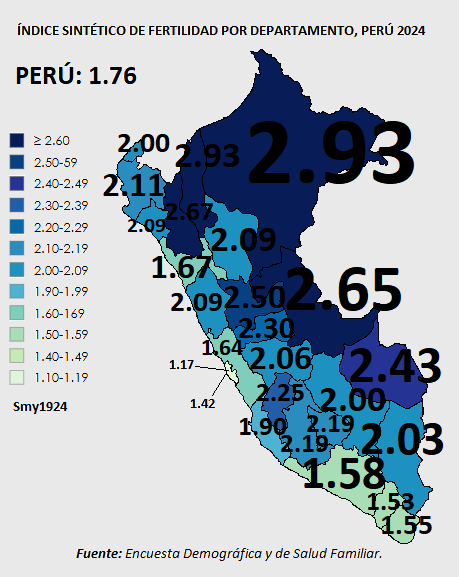Total Fertility Rate Map of Peru 2024


David Chen
Data Visualization Specialist
David Chen is an expert in transforming complex geographic datasets into compelling visual narratives. He combines his background in computer science ...
Geographic Analysis
What This Map Shows
The map titled "Total Fertility Rate (Children per Woman), Perú 2024" provides a visual representation of the average number of children that would be born to a woman over her lifetime based on current age-specific fertility rates in various regions of Peru. This statistic is crucial for understanding demographic trends, population growth, and societal changes within the country. The map highlights the disparities in fertility rates across different provinces and regions, offering a glimpse into the broader socio-economic and cultural factors that influence family planning decisions in Peru.
Deep Dive into Fertility Rates in Peru
Fertility rates are a significant demographic indicator, reflecting various aspects of society, including health care accessibility, education levels, economic conditions, and cultural norms. In Peru, the total fertility rate has shown a general decline over the past few decades, a trend that aligns with global patterns as more women access education and employment opportunities. Interestingly, while the national average fertility rate has decreased, regional variances remain pronounced.
As of 2024, the total fertility rate in Peru is approximately 2.4 children per woman. However, this figure masks important differences across the country. In urban areas, such as Lima, the fertility rate is lower, averaging around 2.0 children per woman, while rural areas, particularly in the Andes and Amazon regions, often report higher rates, sometimes exceeding 3.0 children per woman. This discrepancy can be attributed to several factors, including economic opportunities, access to education and healthcare, and traditional family structures.
The maternal health landscape also plays a critical role in shaping these rates. Peru has made significant strides in improving maternal health services, but challenges remain, particularly in remote areas where access to healthcare is limited. Programs aimed at providing reproductive health education and family planning resources are essential in addressing high fertility rates in specific regions.
What's fascinating is that cultural attitudes towards family size vary significantly. In many indigenous communities, larger families are often seen as beneficial for labor and support, while urban populations may prioritize smaller family units due to economic constraints and lifestyle choices. This divergence underscores the complex interplay between culture, economy, and fertility decisions.
Regional Analysis
When examining the map closely, distinct regional patterns emerge. For instance, in the coastal region of Piura, the fertility rate stands at about 2.8 children per woman, largely influenced by traditional views and limited access to family planning services. Conversely, in the highland region of Cusco, the rate is even higher, averaging around 3.2 children per woman. This can be attributed to both cultural factors and the ongoing challenges in healthcare access in more remote areas.
In contrast, urban centers like Arequipa and Lima exhibit much lower fertility rates, at around 1.9 and 2.0, respectively. These cities are characterized by higher levels of education, economic development, and better access to healthcare services. The shift towards lower fertility rates in urban areas is also indicative of changing societal norms, where smaller family sizes are becoming more common as women increasingly enter the workforce and prioritize educational attainment.
Significance and Impact
Understanding fertility rates is not merely an academic exercise; it has significant implications for policy-making, economic development, and social services in Peru. A declining fertility rate can lead to an aging population, which poses challenges for pension systems and healthcare delivery. Conversely, regions with high fertility rates may struggle to provide adequate services for growing populations, leading to issues such as overcrowding, underfunded schools, and inadequate healthcare.
Moreover, as Peru continues to urbanize, the government must address the needs of both urban and rural populations. Investments in education and healthcare are crucial for managing fertility rates and ensuring sustainable development. With projections indicating that the national fertility rate may continue to decline, understanding and addressing the factors behind regional differences will be essential for crafting effective policies moving forward.
In conclusion, the Total Fertility Rate Map of Peru 2024 serves as a vital tool for visualizing and understanding the complexities surrounding family planning and demographic changes in the nation. By examining this map, we gain valuable insights into the socio-economic dynamics that shape the lives of Peruvian families today and in the future.
Visualization Details
- Published
- August 13, 2025
- Views
- 148
Comments
Loading comments...